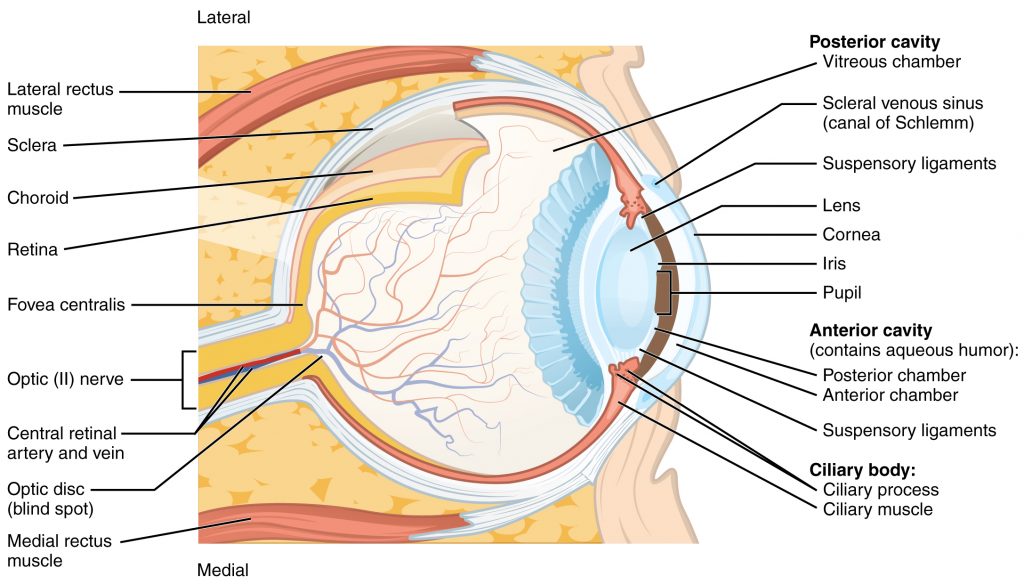
Orbital and Eyelid Tumors
Orbital and Eyelid Tumors
Primary tumors of the eye develop due to unknown reasons. Other eye tumors develop secondary to cancer in another part of the body such as metastasis from skin, breast, lung, or prostate cancer.
Orbital Tumors
The orbit is the bony socket in the skull that holds the eye along with the nerves, muscles and connective tissue associated with the eye and its movement. Orbital tumors are growths that develop anywhere in the orbit and can be benign or malignant.
Because of limited space within the orbit, even small tumors press upon the eye structures causing symptoms such as forward bulging of the eye (proptosis) and vision issues. Depending on the tumor type, it may occur more often in children or adults.
Most orbital tumors in children are benign but require thorough assessment and treatment by an expert. Cavernous hemangiomas are the most common benign orbital tumor occurring in adults. Generally these types of tumors can be safely removed by our surgical specialists.
Types of Orbital Tumors
There is a wide range of orbital tumors including the following:
- Osteomas – Tumors that develop in bone
- Hemangiomas / Lymphangiomas / Hemangiopericytoma – From the vascular system
- Sarcomas -From surrounding fatty tissue or muscle
- Fibrous histiocytomas – Tumors from embryonic cells more often in children
- Dacryoadenitis / Benign mixed tumor /Sarcoidosis / Adenoid cystic carcinoma -Tumors from the lacrimal gland
- Paranasal sinus tumors and mucoceles – Growths that extend from the sinuses into the orbit
- Metastatic cancer – Orbital tumor from other parts of the body
- Pseudotumor / sarcoidosis or infection (abscess) – Orbit tumor caused by inflammation
Symptoms of Orbital Tumors
Symptoms usually include bulging of the eyeball (proptosis) or double vision (diplopia). Other symptoms may include the following:
- Flattened eyeball
- Numbness / tingling
- Uncoordinated eye movement
- Vision disturbance
- Pain
- Swollen / droopy eyelid
Diagnosis & Treatment
The optimal treatment for orbital tumors is sometimes, but not always, surgical removal of the tumor. Due to the delicate nature of the eye and its surroundings, an orbital surgical specialist is recommended.
When the tumor includes, or will be accessed via nasal, sinus or intracranial pathways, a highly specialized multidisciplinary approach is recommended. In cases where the tumor may be inaccessible or the risk may be too great to eye and vision, non-surgical treatment options are available including stereotactic radiation or chemotherapy.
Drs. Krauss and Griffiths were the first in the world to initiate and carry out transnasal endoscopic image-guided orbital tumor surgery, allowing access to difficult to reach tumors by a transnasal route.
Drs. Krauss, Griffiths and associates have been innovative in techniques of cancer surgery, often allowing patients to maintain their eyes and vision, in cases where they may have been told elsewhere that they must give up their eye to treat their cancer.
Optic Nerve Tumors
Most tumors of the optic nerve and its sheath (covering tissue) are benign and are associated with slow progressive visual loss along with optic nerve issues and varying degrees of bulging eyes.
Tumors that affect these areas are generally of the following types:
Optic Nerve Gliomas
Optic nerve gliomas, also called optic gliomas or juvenile pilocytic astrocytomas, tend to be slow growing, low-grade brain tumors that grow on the nerves responsible for carrying vision signals to the brain. In general, they develop in children and arise in the optic chiasm where the left and right optic nerves join. Optic nerve gliomas have been associated with the genetic disorder neurofibromatosis type 1 (NF1).
Symptoms
Optic nerve glioma symptoms develop as a result of the tumor within the optic nerves, chiasm or optic tracts. This may cause the following:
- Nausea and vomiting
- Balance issues
- Vision problems
- Headache
Other symptoms may include:
- Involuntary eye movement
- Memory impairment
- Daytime sleepiness
- Loss of appetite
- Growth delays
- Pituitary-related hormone problems
Diagnosis & Treatment
These kinds of tumors are diagnosed using CT imaging or MRI scans.
In general, childhood gliomas are slow growing and benign, and treatment may only be necessary if there is hypothalamic involvement, painful or disfiguring bulging of an eye, or progressive visual field loss. Surgery by our experts may be recommended for some cases. Adult optic nerve gliomas may be painful and aggressive.
Optic Nerve Sheath Meningiomas
These are rare representing about 2 percent of all orbital tumors. They can develop at any location along the entire length of the optic nerve sheath. Primary optic nerve sheath meningiomas most often develop in middle–aged women. Diagnosis is usually established using high-resolution CT scanning or MR imaging. These are generally slow growing and benign but eventually can lead to blindness. Stereotactic fractionated radiotherapy provides the most consistent and effective treatment with preservation and improvement in visual function in approximately 80 percent of patients.
Secondary optic nerve sheath meningiomas originate intracranially. Treatment is dependent on origin and extent of infiltration and may include surgical removal along with radiotherapy.
Other Tumors
Tumors located around the eye can press onto the structures of the eye affecting vision and movement of the eye. These include the following:
Tumors of the eye mostly arise in the middle and inner layers of the eye.
Middle Layer. Uveal tract (iris, ciliary body and choroid)
Inner Layer. Retina and optic nerve.

